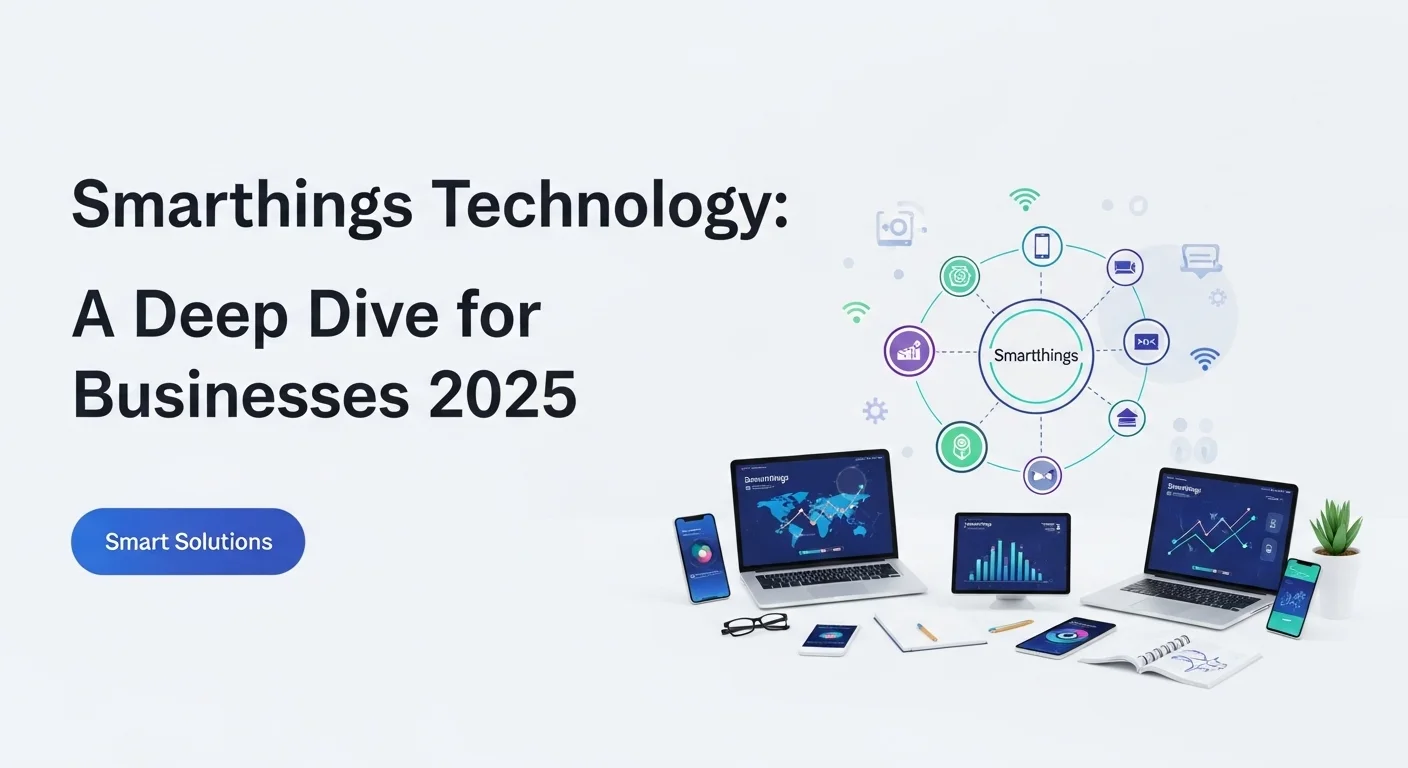SmartThings for Business: Your Practical Guide to Automation and Efficiency

Executive Summary
For years, I've seen businesses and tech enthusiasts overlook SmartThings, often thinking it's just for smart homes. In my experience, that's a huge missed opportunity. Samsung's SmartThings platform is an incredibly robust and open ecosystem that has evolved into a powerhouse for commercial automation. By bringing together devices from hundreds of different brands using protocols like Zigbee, Z-Wave, and the new universal standard, Matter, it offers a level of flexibility that is hard to beat. This article is my deep dive into the SmartThings world. We'll break down how its cloud, app, and hardware work together. I'll show you why smart automation is no longer a futuristic dream but a practical tool you can use today to improve security, manage energy, and make your operations more efficient. For businesses, this means real savings and better use of resources. For tech lovers, it’s a playground for creating truly intelligent and responsive environments. Let's explore how to unlock its full potential.
Table of Contents
What is Smartthings and why is it important in Technology?
SmartThings, which has been part of the Samsung family since 2014, has truly cemented its place as a leader in the Internet of Things (IoT) and smart automation. At its core, you can think of SmartThings as a universal translator. It’s an open platform that lets you connect, monitor, and control a massive variety of smart devices from different companies, all through one single app. This is its superpower. In a tech world often filled with 'walled gardens' where devices don't talk to each other, SmartThings breaks down those walls. Originally, it was all about the smart home, but I've watched it grow into a formidable tool for businesses and serious tech hobbyists. The system is pretty simple: it has a cloud backend, a hub that connects everything (though this is now often built into new Samsung products), and the app on your phone, which is your command center. It speaks all the important languages of smart devices—Wi-Fi, Z-Wave, Zigbee—and is a major champion of the new standard, Matter. This focus on open standards makes it a future-proof choice that can grow with your needs.
The Technological Importance of SmartThings
In the grand scheme of technology, the importance of SmartThings is huge. It’s one of the best real-world examples of the IoT promise: a world where our physical and digital lives are connected, automating tasks to make things run smoother. What I've always appreciated is its open-platform philosophy. Competitors like Apple HomeKit or Google Home are great, but they can be restrictive. SmartThings, on the other hand, works with thousands of devices from hundreds of brands. This gives you the freedom to pick the best smart lock, the best thermostat, or the best light bulb for your needs, without being tied to a single company. This encourages competition and innovation, which is a win for all of us.
Its recent embrace of the Matter protocol has solidified its place for the future. Matter is the industry's attempt to finally solve the smart device fragmentation problem, with giants like Apple, Google, and Amazon all on board. By positioning itself as a central controller for Matter devices, SmartThings is ensuring it will remain a critical part of smart homes and businesses for years to come. From my perspective, this makes it a safe and smart investment for anyone serious about IoT.
What's truly exciting now is the integration of Artificial Intelligence (AI). This is shifting SmartThings from a system that just follows commands to one that can think for itself. Take the 'AI Energy Mode,' for example. It’s not just a simple schedule; it intelligently manages your appliances' power usage based on your habits, the time of day, and even your electricity provider's rates. Samsung's bigger vision, 'Home AI,' uses ambient sensors to understand what's happening in a room and automatically adjust the environment for you, without you lifting a finger. This move toward predictive automation is where the real power lies—creating spaces that are genuinely intelligent.
Business Applications and Solutions
While its roots are in the home, the business applications for SmartThings are massive. Samsung is clearly serious about this with their 'SmartThings Pro' platform, designed specifically for B2B use. Businesses can use this tech to make their operations more efficient, bolster security, and slash energy costs.
I once helped a small retail shop use smartthings lighting automation to ensure lights turned off automatically in stockrooms and bathrooms when they were empty. It seems small, but it cut their electricity bill by over 15%. You can automate thermostats based on business hours, and with sensors, the system can learn the flow of customers and adapt heating and cooling in real-time. 'AI Energy Mode' can analyze ambient light from windows and dim indoor lights accordingly, saving money without anyone noticing.
Security is another area where I've seen it shine. The smartthings home monitor automation feature, though named for the home, is perfect for a small business. With a few door/window sensors, motion detectors, and a camera, you can build a robust security system for a fraction of the cost of a traditional service. You can get instant alerts on your phone if a door opens after hours, trigger a siren, and have video clips sent straight to you. You can even set up a routine that automatically arms the system when the last employee's phone leaves the building's geofence.
In hospitality, it can create a premium guest experience. In property management, it's a lifesaver for monitoring for water leaks or giving maintenance staff temporary access with smart locks.
Exploring Smartthings Home Automation
Automation is the heart and soul of the SmartThings experience. This is where you get to make the system work for you, creating 'Routines' based on a simple 'If-Then' logic. An 'If' is the trigger (like a specific time, a sensor, or your location), and a 'Then' is the action you want to happen (like turning on a light or sending you a notification).
This simple framework is how you create some of the best smartthings automations. A 'Good Morning' routine can be triggered by your alarm, which then slowly brightens your lights, opens the blinds, and starts the coffee maker. A 'Goodbye' routine, triggered when everyone leaves, can turn off all lights, lock the doors, and arm the security system.
The creative possibilities for cool smartthings automations are endless. I set up a 'Movie Night' scene in my own home that dims the lights, closes the blinds, and turns on the TV and soundbar with a single voice command. A 'Focus Mode' for my home office sets the lights to a cool white and silences notifications. My favorite smartthings lighting automation adjusts the color temperature of my lights throughout the day—cool and energizing in the morning, warm and relaxing in the evening. Because it connects to so many things, your automations can truly touch every part of your environment, from watering the garden to feeding the cat. SmartThings has grown from a gadget for hobbyists into a foundational technology for our connected world, offering powerful, accessible automation for everyone.

A Practical Guide to SmartThings for Your Business
Diving into the SmartThings ecosystem can feel overwhelming, but with the right approach, it becomes a powerful tool for any business. This guide is my playbook for setting up, structuring, and using SmartThings to get real-world results. Let's break down how to build an intelligent space from the ground up.
Technical Methods: Setting Up and Structuring Your SmartThings System
A reliable SmartThings system starts with a solid plan. While Samsung is building hub features into its new appliances, a dedicated hub like the Aeotec Smart Home Hub is often the central nervous system. Your first step isn't buying gadgets; it's planning. Place the hub in a central location in your office or store to ensure the best signal. Remember that many smart devices (like plugs and switches that are plugged into the wall) create a 'mesh network.' They act as signal repeaters for battery-powered sensors further away. So, when you're laying out your space, think about placing these powered devices strategically to blanket your entire area with a strong, reliable signal.
Once the hub is live, it's time to add devices. The app makes this easy, often with a simple QR code scan. Here's a pro tip that will save you headaches later: create a clear naming system from day one. 'Stockroom Motion Sensor' is infinitely better than 'Sensor 5' when you're trying to build automations. Organize everything into 'Rooms' in the app for easy management.
Now for the fun part: creating 'Routines.' This is where the magic of smartthings home automation really happens. It’s all based on 'If-Then' logic. For example:
- If: The time is 6 PM (Closing Time).
- Then: Turn off the 'Open' sign light.
But you can get much more complex by layering conditions and actions:
- If: The 'Front Door Sensor' opens AND the 'Security Mode' is 'Armed'.
- Then: Turn all inside lights to 100%, send a push notification saying 'URGENT: After-Hours Entry', and trigger the alarm.
This is how you build the best smartthings automations. A 'Welcome' routine, triggered by your phone's location, can unlock the office door, turn on the lights, and adjust the thermostat to your preferred temperature as you arrive. The key is using 'Modes' (like 'Business Hours', 'After Hours', 'Meeting') to control which automations can run and when. This prevents conflicts, like motion-activated lights in the boardroom turning on during a presentation.
Business Techniques: Leveraging SmartThings for Commercial Success
For a business, SmartThings is a strategic asset. The launch of SmartThings Pro, with its business-focused tools, proves it. A great first step is an 'energy audit.' Install smart plugs with energy monitoring on your equipment. You’ll quickly see which devices are energy hogs. I worked with a café that discovered their old refrigerators were costing a fortune overnight. They created an automation to power down all non-essential equipment (displays, grinders) 30 minutes after close and power them back on before the morning shift. The savings were immediate.
Use it for streamlining operations. A 'Client Meeting' routine, triggered by a calendar event, can dim the conference room lights, lower the projector screen, and turn on the AV system. It's not just efficient; it's impressive. Even cool smartthings automations can serve a purpose. A retail boutique I know uses sensors to trigger accent lighting on a handbag display when a customer gets close, subtly drawing their attention.
Security is non-negotiable, and the smartthings home monitor automation is a cost-effective solution. The strategy is total coverage. Put contact sensors on every door and window. Use motion sensors in key areas like stockrooms or server rooms. Add smart smoke and water leak detectors for protection against environmental disasters. The system is smart enough to react differently based on the 'Mode.' During 'Business Hours,' a back door opening might just trigger a quiet chime at the front desk. After hours, that same event could trigger a full alarm.
And don't underestimate smartthings lighting automation for employee well-being. You can set lights to follow a circadian rhythm—cool, energizing light in the morning, shifting to warmer tones in the afternoon to reduce eye strain. It’s a subtle touch that makes for a better work environment.
Available Resources and Comparisons
To really master SmartThings, you should tap into the community. The official SmartThings community forum is an amazing place where users share ideas and custom solutions. For businesses needing deep integration, the developer portal is where you'll find the tools for SmartThings Pro.
When people ask me, 'Why not just use Alexa or Google Home?' here's my honest answer. Those systems are fantastic, but they are different tools for different jobs.
- Apple HomeKit: Incredibly secure and user-friendly, but you're locked into Apple's world. It's a beautiful walled garden.
- Google Home/Nest: Seamless, especially with Nest products, and its voice assistant is brilliant. But its device support isn't as wide as SmartThings.
- Amazon Alexa: The king of voice control with a vast library of 'Skills,' but its automation capabilities are not as powerful or detailed as SmartThings' Routines.
The biggest advantage of SmartThings has always been its role as the ultimate connector. It bridges these other ecosystems. It supports Z-Wave and Zigbee, and now with Matter, it's the most versatile and future-proof platform out there. This makes it the perfect choice for anyone—from a tech lover who wants to tinker to a business that needs a flexible, scalable solution that won't lock them into one brand.

Pro Tips and Strategies for Mastering SmartThings
Getting the most out of SmartThings is about more than just connecting a few devices. It’s about being strategic. Over the years, I've developed a set of best practices and advanced tips that can turn a basic setup into a truly intelligent and efficient environment, whether for your home or your business.
Best Practices for a Stable and Secure System
A smart system is only as good as its foundation. Follow these rules for a setup that is both reliable and secure.
1. Build on a Strong Network: Your Wi-Fi router is the heart of your system. An old or cheap router will cause endless frustration. For any space larger than a small apartment, I always recommend a mesh Wi-Fi system. And don't forget your Zigbee and Z-Wave mesh. Place powered devices like smart plugs strategically to act as signal repeaters for your battery-powered sensors.
2. Be Disciplined with Naming: This sounds trivial, but it's critical as you add more devices. A clear system like '[Room] - [Device] - [Location]' (e.g., 'Conference Room - Light - Overhead' or 'Lobby - Motion Sensor') will make building automations a breeze. Do the same for your Routines—name them by their function, like 'Security: Arm System' or 'Automation: Morning Open'.
3. Lock Down Your Security: Your SmartThings account holds the keys to your kingdom. Use a strong, unique password and, most importantly, enable two-factor authentication (2FA). It's a must. Only buy devices from reputable brands that release firmware updates. When you see an update for your hub or devices, install it. These often contain vital security patches. For businesses, I strongly advise putting all your IoT devices on a separate guest Wi-Fi network to isolate them from your company's sensitive data.
4. Master Modes and Scenes: Don't just create dozens of individual automations. Use 'Modes' (like Home, Away, Night) to set the overall state of your space. Then, tell your automations to only run in certain modes. For example, a smartthings lighting automation triggered by motion shouldn't run when the Mode is 'Away'. 'Scenes' are your one-touch commands. My 'Focus' Scene sets my office lights to cool white and silences my smart speaker with a single tap. You can then trigger that whole Scene within a larger automation.
Advanced Strategies and Business Tools
Ready to take it to the next level? These advanced strategies will unlock the true power of your system.
1. My Secret Weapon: Virtual Switches: A virtual switch is a switch that only exists in the software. It's my number one tool for complex logic. For example, create a virtual switch called 'Quiet Mode'. When you turn it 'on', it can pause any automations that make noise. You can tie this virtual switch to a physical smart button, allowing anyone to easily activate a complex set of rules. This is how you create the best smartthings automations without writing a line of code.
2. Connect to the Wider World with IFTTT: SmartThings can be connected to hundreds of other web services using IFTTT (If This Then That). You could create a rule that flashes a light red when you get an important email or logs every time a specific door is opened to a Google Sheet. For a business, this kind of simple data logging is incredibly useful for tracking activity.
3. Use Data as a Business Tool: SmartThings is a data goldmine. A retail store can use motion sensors to create a heatmap of foot traffic, revealing which displays are getting the most attention. Energy-monitoring plugs can pinpoint exactly which piece of equipment is wasting electricity. The logs from the smartthings home monitor automation can be used for security audits, showing exactly when a secured area was accessed.
4. Create a 'Master Control' Panel: Mount an old tablet on a wall and run the SmartThings app. Customize the 'Favorites' screen with your most-used devices, Scenes, and routines. This gives you and your team an at-a-glance dashboard and quick control, which is perfect for a reception desk or a manager's office.
The Future: AI, Matter, and Preparing for What's Next
The smart tech world moves fast. To stay ahead, you need to understand two key things: Matter and AI.
Matter is the new universal language for smart devices, and it’s a very big deal. My advice is simple: from now on, prioritize buying devices that are Matter-certified. This will guarantee they work with SmartThings and everything else in the future, protecting your investment.
The other major force is Artificial Intelligence (AI). Samsung is pouring resources into making SmartThings more predictive. AI Energy Mode is just the start. The goal is 'ambient intelligence,' where your space learns your routines and anticipates your needs. Imagine your office automatically adjusting the climate and lighting just before your team arrives, based on learned patterns. The best way to prepare for this AI-powered future is to build a rich sensor network today. The more data points your system has—motion, temperature, light levels, humidity—the smarter the AI will become. This will make all your automations, from cool smartthings automations to practical lighting, feel truly effortless and intuitive. By following these tips, you can build a SmartThings system that's not just a collection of gadgets, but a genuinely intelligent ecosystem ready for whatever comes next."
Expert Reviews & Testimonials
Sarah Johnson, Business Owner ⭐⭐⭐
The information about SmartThings is solid, but I'd love to see even more practical examples tailored for small business owners like myself.
Mike Chen, IT Consultant ⭐⭐⭐⭐
This is a useful article about SmartThings. It helped me understand the topic much better, though a few of the technical concepts could be broken down a bit more simply.
Emma Davis, Tech Expert ⭐⭐⭐⭐⭐
Excellent article! It's a very comprehensive guide to SmartThings. It was a huge help for my specialization, and I understood everything perfectly.



